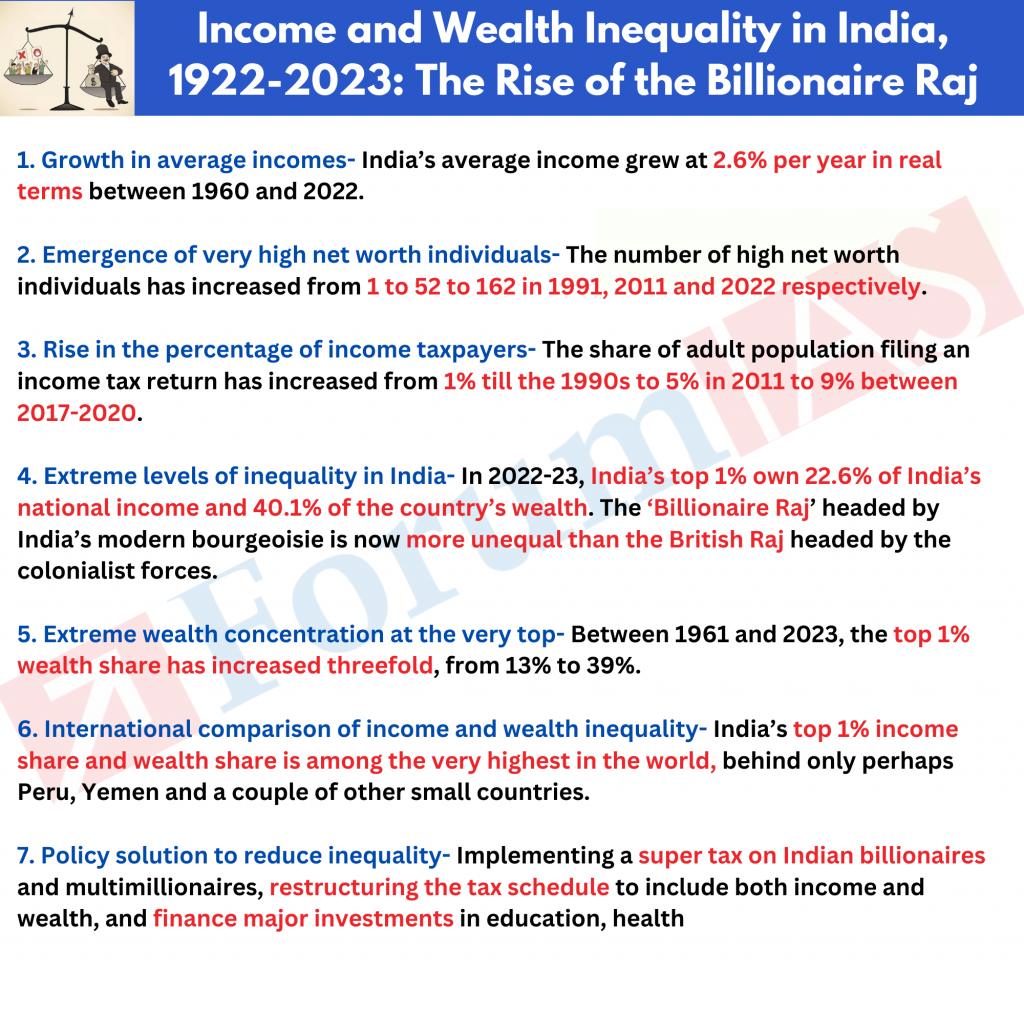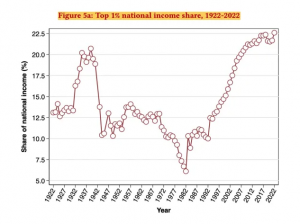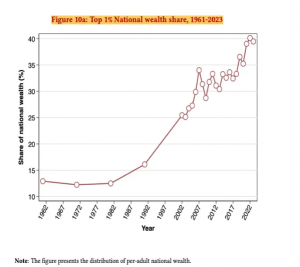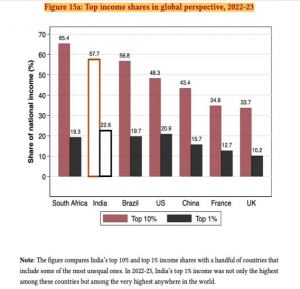ForumIAS announcing GS Foundation Program for UPSC CSE 2025-26 from 19 April. Click Here for more information.
ForumIAS Answer Writing Focus Group (AWFG) for Mains 2024 commencing from 24th June 2024. The Entrance Test for the program will be held on 28th April 2024 at 9 AM. To know more about the program visit: https://forumias.com/blog/awfg2024
The recent working paper by World Inequality Lab titled ‘Income and Wealth Inequality in India, 1922-2023: The Rise of the Billionaire Raj‘ has put the spotlight on the status of inequality in India. According to the estimates of the paper, post-independence till the early 1980s, inequality declined in India. After 1980 inequality began rising and inequality has skyrocketed since the early 2000s.
The report combines data from national income accounts, wealth aggregates, tax tabulations, rich lists, and surveys on income, consumption, and wealth to arrive at the results.

What are the main takeaways of the report?
1. Growth in average incomes- India’s average income grew at 2.6% per year in real terms between 1960 and 2022.
2. Emergence of very high net worth individuals- The period between 1990 to 2022 witnessed a rise in national wealth and the emergence of very high net worth individuals (those with net wealth exceeding $1 billion at market exchange rate). The number of high net worth individuals has increased from 1 to 52 to 162 in 1991, 2011 and 2022 respectively.
3. Rise in the percentage of income taxpayers- The share of adult population filing an income tax return has increased from 1% till the 1990s to 5% in 2011 to 9% between 2017-2020.
4. Extreme levels of inequality in India- In 2022-23, India’s top 1% own 22.6% of India’s national income and 40.1% of the country’s wealth. The ‘Billionaire Raj’ headed by India’s modern bourgeoisie is now more unequal than the British Raj headed by the colonialist forces.

5. Extreme wealth concentration at the very top- Between 1961 and 2023, the top 1% wealth share has increased threefold, from 13% to 39%.

6. International comparison of income and wealth inequality- India’s top 1% income share and wealth share is among the very highest in the world, behind only perhaps Peru, Yemen and a couple of other small countries. India has one of the highest wealth and income inequality in the world.

7. Poor Economic data- Quality of economic data in India is notably poor, and it has seen a decline recently, leading to likely underestimation of level of inequality.
8. Policy solution to reduce inequality- Implementing a super tax on Indian billionaires and multimillionaires, restructuring the tax schedule to include both income and wealth, and finance major investments in education, health and other public infrastructure, could be effective measures to reduce inequality in India.
What are the implications of rising inequality in India?
1. Higher Vulnerabilities to Extreme Events- Poor people have little to no savings or wealth which makes it very difficult for them to survive in extreme situations like Pandemic, Disasters etc.
2. Hampers progress of Future Generations- Lack of access to income and wealth hampers the ability of the poor to access the levers, like education, that enable upward mobility. Children born in poor families remain perpetually trapped in poverty.
3. Undermines Dignity- People with less resources have to work day and night without any day off, unlike the affluent section. They starve for food, clothing and other basic things, which undermines their right to a dignified life under Article 21.
4. High Crime Rates- Inequitable distribution of wealth leads to lower social trust and higher crime rates.
What are the challenges in addressing inequality?
1. Low Female Labour Force Participation Rate- Lack of Education, Early Marriage, household responsibilities etc. force women to opt out of jobs which reduces their income and increases income inequalities.
2. Poor Coverage of Schemes- There is poor coverage of health and education schemes, which increases the out-of-Pocket expenditure of poor people and exacerbates income and wealth inequalities.
3. Global Uncertainties- The continuation of COVID-19 and Russia-Ukraine conflict have pushed the inflation levels in the country, thereby increasing income and wealth inequality in India.
4. High level of in-formalisation of economy- A significant portion of India’s workforce is engaged in the informal sector, which typically lacks job security, social protections, and access to formal financial services. Workers in the informal sector often face exploitative working conditions and lower wages compared to their counterparts in the formal sector.
5. Skewed Economic Growth Patterns- High growth rates have primarily benefited certain sectors and regions, leading to a concentration of wealth and opportunities among a relatively small portion of the population.
What steps have been taken by the government to reduce inequality in India?
| JAM Trinity | It focuses on mobile numbers, Aadhaar Card and post office accounts as alternative financial delivery mechanisms to ensure that benefits reach the poor households seamlessly. |
| Ayushman Bharat | It focuses on providing care through Health Wellness Centres (AB-HWC) covering child and maternal health services, non-communicable diseases, and free drugs and diagnostic services. |
| Samagra Shiksha Abhiyan | It is an Integrated Scheme for School Education. This programme subsumes the three erstwhile Centrally Sponsored Schemes of Sarva Shiksha Abhiyan (SSA), Rashtriya Madhyamik Shiksha Abhiyan (RMSA) and Teacher Education (TE). |
| MGNREGA | It guarantees 100 days of work a year to every rural household with an aim to enhance the livelihood security of people. |
What Should be the Way Forward?
1. Super Tax or Wealth Tax- The government should levy wealth tax and super tax on Indian billionaires and multimillionaires. This will reduce levels of income inequality in India.
2. Raising minimum wage rate- The government should raise the minimum wage rate especially in the unorganized sector wherein people get very less social security benefits like gig workers and gig economy.
3. Higher investment in Education and Health- The government of India must invest 6% of GDP in Education and 2.5% of GDP in Health to ensure equitable development and reduce inequalities in the country.
4. Reduce exclusion error in schemes- There should be greater focus on digitization and JAM usage in order to reduce inclusion and exclusion errors in schemes.
| Read More- The Indian Express UPSC Syllabus- GS 3- Inclusive Growth In India |




